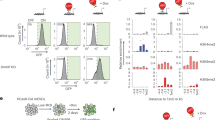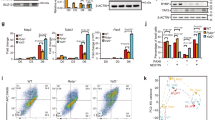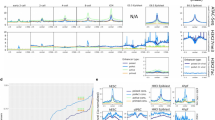Abstract
EZH2 is the catalytic subunit of PRC2, a central epigenetic repressor essential for development processes in vivo and for the differentiation of embryonic stem cells (ESCs) in vitro. The biochemical function of PRC2 in depositing repressive H3K27me3 marks is well understood, but how it is regulated and directed to specific genes before and during differentiation remains unknown. Here, we report that PRC2 binds at low levels to a majority of promoters in mouse ESCs, including many that are active and devoid of H3K27me3. Using in vivo RNA-protein cross-linking, we show that EZH2 directly binds the 5′ region of nascent RNAs transcribed from a subset of these promoters and that these binding events correlate with decreased H3K27me3. Our findings suggest a molecular mechanism by which PRC2 senses the transcriptional state of the cell and translates it into epigenetic information.
This is a preview of subscription content, access via your institution
Access options
Subscribe to this journal
Receive 12 print issues and online access
$189.00 per year
only $15.75 per issue
Buy this article
- Purchase on Springer Link
- Instant access to full article PDF
Prices may be subject to local taxes which are calculated during checkout





Similar content being viewed by others
References
Bonasio, R., Tu, S. & Reinberg, D. Molecular signals of epigenetic states. Science 330, 612–616 (2010).
Margueron, R. & Reinberg, D. The Polycomb complex PRC2 and its mark in life. Nature 469, 343–349 (2011).
Ringrose, L. & Paro, R. Epigenetic regulation of cellular memory by the Polycomb and Trithorax group proteins. Annu. Rev. Genet. 38, 413–443 (2004).
Cao, R. et al. Role of histone H3 lysine 27 methylation in Polycomb-group silencing. Science 298, 1039–1043 (2002).
Czermin, B. et al. Drosophila enhancer of Zeste/ESC complexes have a histone H3 methyltransferase activity that marks chromosomal Polycomb sites. Cell 111, 185–196 (2002).
Kuzmichev, A., Nishioka, K., Erdjument-Bromage, H., Tempst, P. & Reinberg, D. Histone methyltransferase activity associated with a human multiprotein complex containing the Enhancer of Zeste protein. Genes Dev. 16, 2893–2905 (2002).
Müller, J. et al. Histone methyltransferase activity of a Drosophila Polycomb group repressor complex. Cell 111, 197–208 (2002).
Margueron, R. et al. Role of the polycomb protein EED in the propagation of repressive histone marks. Nature 461, 762–767 (2009).
Lewis, P.W. et al. Inhibition of PRC2 activity by a gain-of-function H3 mutation found in pediatric glioblastoma. Science 340, 857–861 (2013).
Ernst, T. et al. Inactivating mutations of the histone methyltransferase gene EZH2 in myeloid disorders. Nat. Genet. 42, 722–726 (2010).
Nikoloski, G. et al. Somatic mutations of the histone methyltransferase gene EZH2 in myelodysplastic syndromes. Nat. Genet. 42, 665–667 (2010).
Shih, A.H., Abdel-Wahab, O., Patel, J.P. & Levine, R.L. The role of mutations in epigenetic regulators in myeloid malignancies. Nat. Rev. Cancer 12, 599–612 (2012).
Margueron, R. et al. Ezh1 and Ezh2 maintain repressive chromatin through different mechanisms. Mol. Cell 32, 503–518 (2008).
Rinn, J.L. et al. Functional demarcation of active and silent chromatin domains in human HOX loci by noncoding RNAs. Cell 129, 1311–1323 (2007).
Zhao, J., Sun, B.K., Erwin, J.A., Song, J.-J. & Lee, J.T. Polycomb proteins targeted by a short repeat RNA to the mouse X chromosome. Science 322, 750–756 (2008).
Pandey, R.R. et al. Kcnq1ot1 antisense noncoding RNA mediates lineage-specific transcriptional silencing through chromatin-level regulation. Mol. Cell 32, 232–246 (2008).
Khalil, A. et al. Many human large intergenic noncoding RNAs associate with chromatin-modifying complexes and affect gene expression. Proc. Natl. Acad. Sci. USA. 106, 11667–11672 (2009).
Zhao, J. et al. Genome-wide identification of polycomb-associated RNAs by RIP-seq. Mol. Cell 40, 939–953 (2010).
Klattenhoff, C.A. et al. Braveheart, a long noncoding RNA required for cardiovascular lineage commitment. Cell 152, 570–583 (2013).
Kanhere, A. et al. Short RNAs are transcribed from repressed polycomb target genes and interact with polycomb repressive complex-2. Mol. Cell 38, 675–688 (2010).
Brockdorff, N. Noncoding RNA and Polycomb recruitment. RNA 19, 429–442 (2013).
Li, G. et al. Jarid2 and PRC2, partners in regulating gene expression. Genes Dev. 24, 368–380 (2010).
Kaneko, S. et al. Phosphorylation of the PRC2 component Ezh2 is cell cycle-regulated and up-regulates its binding to ncRNA. Genes Dev. 24, 2615–2620 (2010).
Ciferri, C. et al. Molecular architecture of human polycomb repressive complex 2. eLife 1, e00005 (2012).
Jensen, K.B. & Darnell, R.B. CLIP: crosslinking and immunoprecipitation of in vivo RNA targets of RNA-binding proteins. Methods Mol. Biol. 488, 85–98 (2008).
Hafner, M. et al. Transcriptome-wide identification of RNA-binding protein and microRNA target sites by PAR-CLIP. Cell 141, 129–141 (2010).
Corcoran, D.L. et al. PARalyzer: definition of RNA binding sites from PAR-CLIP short-read sequence data. Genome Biol. 12, R79 (2011).
Guttman, M. et al. lincRNAs act in the circuitry controlling pluripotency and differentiation. Nature 477, 295–300 (2011).
Guil, S. et al. Intronic RNAs mediate EZH2 regulation of epigenetic targets. Nat. Struct. Mol. Biol. 19, 664–670 (2012).
Boyer, L.A. et al. Polycomb complexes repress developmental regulators in murine embryonic stem cells. Nature 441, 349–353 (2006).
Marks, H. et al. The transcriptional and epigenomic foundations of ground state pluripotency. Cell 149, 590–604 (2012).
Mikkelsen, T.S. et al. Genome-wide maps of chromatin state in pluripotent and lineage-committed cells. Nature 448, 553–560 (2007).
Ringrose, L. & Paro, R. Epigenetic regulation of cellular memory by the Polycomb and Trithorax group proteins. Annu. Rev. Genet. 38, 413–443 (2004).
Mendenhall, E.M. et al. GC-rich sequence elements recruit PRC2 in mammalian ES cells. PLoS Genet. 6, e1001244 (2010).
Brien, G.L. et al. Polycomb PHF19 binds H3K36me3 and recruits PRC2 and demethylase NO66 to embryonic stem cell genes during differentiation. Nat. Struct. Mol. Biol. 19, 1273–1281 (2012).
Kim, H., Kang, K. & Kim, J. AEBP2 as a potential targeting protein for Polycomb Repression Complex PRC2. Nucleic Acids Res. 37, 2940–2950 (2009).
Voigt, P. et al. Asymmetrically modified nucleosomes. Cell 151, 181–193 (2012).
Schmitges, F.W. et al. Histone methylation by PRC2 is inhibited by active chromatin marks. Mol. Cell 42, 330–341 (2011).
Struhl, G. & Akam, M. Altered distributions of Ultrabithorax transcripts in extra sex combs mutant embryos of Drosophila. EMBO J. 4, 3259–3264 (1985).
Papp, B. & Müller, J. Histone trimethylation and the maintenance of transcriptional ON and OFF states by trxG and PcG proteins. Genes Dev. 20, 2041–2054 (2006).
Schmitt, S., Prestel, M. & Paro, R. Intergenic transcription through a polycomb group response element counteracts silencing. Genes Dev. 19, 697–708 (2005).
Davidovich, C., Zheng, L., Goodrich, K.J. & Cech, T.R. Nat. Struct. Mol. Biol., 10.1038/nsmb.2679 (29 September 2013).
Lee, J.T. Lessons from X-chromosome inactivation: long ncRNA as guides and tethers to the epigenome. Genes Dev. 23, 1831–1842 (2009).
Kaneko, S., Rozenblatt-Rosen, O., Meyerson, M. & Manley, J.L. The multifunctional protein p54nrb/PSF recruits the exonuclease XRN2 to facilitate pre-mRNA 3′ processing and transcription termination. Genes Dev. 21, 1779–1789 (2007).
Gao, Z. et al. PCGF homologs, CBX proteins, and RYBP define functionally distinct prc1 family complexes. Mol. Cell 45, 344–356 (2012).
Hafner, M. et al. PAR-CliP: a method to identify transcriptome-wide the binding sites of RNA binding proteins. J. Vis. Exp. 41, 2034 (2010).
Rabani, M. et al. Metabolic labeling of RNA uncovers principles of RNA production and degradation dynamics in mammalian cells. Nat. Biotechnol. 29, 436–442 (2011).
Dölken, L. et al. High-resolution gene expression profiling for simultaneous kinetic parameter analysis of RNA synthesis and decay. RNA 14, 1959–1972 (2008).
Parkhomchuk, D. et al. Transcriptome analysis by strand-specific sequencing of complementary DNA. Nucleic Acids Res. 37, e123 (2009).
Langmead, B., Trapnell, C., Pop, M. & Salzberg, S.L. Ultrafast and memory-efficient alignment of short DNA sequences to the human genome. Genome Biol. 10, R25 (2009).
Heinz, S. et al. Simple combinations of lineage-determining transcription factors prime cis-regulatory elements required for macrophage and B cell identities. Mol. Cell 38, 576–589 (2010).
Zhang, Y. et al. Model-based analysis of ChIP-Seq (MACS). Genome Biol. 9, R137 (2008).
Ross-Innes, C.S. et al. Differential oestrogen receptor binding is associated with clinical outcome in breast cancer. Nature 481, 389–393 (2012).
Wang, L., Feng, Z., Wang, X. & Zhang, X. DEGseq: an R package for identifying differentially expressed genes from RNA-seq data. Bioinformatics 26, 136–138 (2010).
Huang, D., Sherman, B.T. & Lempicki, R.A. Systematic and integrative analysis of large gene lists using DAVID bioinformatics resources. Nat. Protoc. 4, 44–57 (2009).
Acknowledgements
We thank W.W. Tee, L. Vales and P. Voigt for their critical assessment of the manuscript, T. Cech (University of Colorado Boulder) for discussions and the Genome Technology Center at New York University for help with sequencing. This work was supported by grants from the US National Institutes of Health (GM-64844 and R37-37120 to D.R.) and the Howard Hughes Medical Institute (to D.R.). R.B. was supported by a Helen Hay Whitney Foundation postdoctoral fellowship and by the Helen L. and Martin S. Kimmel Center for Stem Cell Biology postdoctoral fellow award.
Author information
Authors and Affiliations
Contributions
S.K., J.S., S.S.S., D.R. and R.B. designed and performed experiments, analyzed data and wrote the manuscript.
Corresponding authors
Ethics declarations
Competing interests
The authors declare no competing financial interests.
Integrated supplementary information
Supplementary Figure 1 Generation and validation of mouse ESCs expressing epitope-tagged EZH2.
(a) Schematic diagram indicating the domain structure of EZH2 and the identity and position of the epitope tags in the N3-EZH2 construct. The FLAG tag and Tobacco Etch Virus protease (TEV) recognition site are also indicated although they were not utilized in the experiments described herein. The domain structure of EZH2 refers to NP_031997.2 and is adapted from ref. 24. (b) Western blots from N3-EZH2 ESCs with or without doxycycline (dox) induction. Immunoblots were performed with the indicated antibodies. The position of the epitope-tagged (N3-EZH2) and endogenous (EZH2) protein is indicated in the EZH2 immunoblot. Notice that most endogenous EZH2 is knocked down by an inducible shRNA. (c) View of a large region of mouse chromosome 14, showing profiles for two independent ChIP-seq performed with antibodies against endogenous EZH2, before induction of the N3–EHZ2 transgene, and one ChIP-seq performed with an HA antibody after induction of N3–EZH2. (d) Genome wide correlation profile of endogenous EZH2 ChIP-seq (x axis) and transgenic N3–EZH2 ChIP-seq (y axis) as computed using DiffBind53 over all EZH2 ERs (28,365) identified by MACS52.
Supplementary Figure 2 PAR-CLIP for EZH2 in mouse ESCs.
(a) Correlation plot for CLIP tag density on RefSeq gene bodies obtained in 4 separate biological replicates. Because of limited coverage, the replicates were paired 2 by 2. A similar correlation was observed when the order of pairing was inverted. (b) Same as a, but the gene bodies of the 250 genes containing the most RCSs were divided in 10 windows, to analyze the degree of spatial consistency between replicates. (c) Additional examples of EZH2 CLIP tags mapping to the 5' of nascent transcripts originating from protein-coding genes. A track for EZH2 ChIP-seq is also shown and the scale is indicated to the right in reads per 10 million mapped (RP10M). RCSs called by PARalyzer are shown as red bars. (d) Density profile of CLIP tags over the 250 unique RefSeq transcripts with the highest CLIP tag density. Transcripts were normalized for length and divided in 100 bins. The position of the transcription start site (TSS) and termination site (TTS) is shown. The profile includes the 10 kb upstream and downstream, each divided in 50 200 nts bins. The profile for RNA-seq reads (gray dashed line) is shown for comparison.
Supplementary Figure 3 5' bias of EZH2 binding as a function of bioinformatic cutoffs.
The smoothed density profile for RCSs (a) and CLIP tags (b) is shown as in Fig. 2c and Supplementary Fig. 2d over an increasingly restricted set of RefSeq genes (numbers are indicated in the plots) obtained by varying the cutoff of number of RCSs (a) or CLIP tags (b) required for inclusion.
Supplementary Figure 4 ezRNAs originate from PRC2+ and H3K27me−, nonbivalent promoters.
(a) Normalized and sorted EZH2 occupancy heatmap (bottom) for all unique RefSeq transcripts in E14 cells grown in serum. The distribution of ezRNA+ genes relative to the heatmap is shown by black lines (middle) and a smoothed density plot (top). The control is a random permutation of the same distribution (dashed gray line). Data was obtained from GSM59011531. (b) As in a, but for H3K27me3. Data was obtained from GSM59013231. (c, d) Venn diagram showing lack of overlap between ezRNA+ genes and bivalent genes, as defined by Mikkelsen et al.32 (c) or Marks et al.31 (d). (e) Normalized heatmaps for chromatin occupancy of EZH2 and SUZ12 in E14 mouse ESCs on all unique RefSeq TSSs. Both heatmaps were sorted by EZH2 occupancy (indicated by the arrow) and show the average of two biological replicates.
Supplementary Figure 5 Relationship between H3K27me3 levels and ezRNA production.
(a) Correlation analysis between H3K27me3 and EZH2 densities at single ezRNA+ genes (dark gray points, black regression line) or a control set (light gray points, dashed gray regression line) equalized by PRC2 levels as in Fig. 4a (left panel) or RPKMs as in Fig. 4b (right panel). Densities are plotted as log2(RP10M) in each 10 kb window spanning the TSS. (b) Density profiles for H3K27me3 in E14 (left panels) or TNGA (right panels) mouse ESCs grown in serum (top) or 2i (bottom) conditions. The profiles were calculated on the promoters of 1,108 ezRNA+ transcripts (black line) or an equally sized control set of promoters (gray dashed line) matched individually for EZH2 occupancy in E14 cells.
Supplementary information
Supplementary Text and Figures
Supplementary Figures 1–6 and Supplementary Tables 1–3 (PDF 3673 kb)
Rights and permissions
About this article
Cite this article
Kaneko, S., Son, J., Shen, S. et al. PRC2 binds active promoters and contacts nascent RNAs in embryonic stem cells. Nat Struct Mol Biol 20, 1258–1264 (2013). https://doi.org/10.1038/nsmb.2700
Received:
Accepted:
Published:
Issue Date:
DOI: https://doi.org/10.1038/nsmb.2700
This article is cited by
-
Repression of the PRELP gene is relieved by histone deacetylase inhibitors through acetylation of histone H2B lysine 5 in bladder cancer
Clinical Epigenetics (2022)
-
Rixosomal RNA degradation contributes to silencing of Polycomb target genes
Nature (2022)
-
Regulatory non-coding RNAs: everything is possible, but what is important?
Nature Methods (2022)
-
C11orf95-RELA fusion drives aberrant gene expression through the unique epigenetic regulation for ependymoma formation
Acta Neuropathologica Communications (2021)
-
Motif-driven interactions between RNA and PRC2 are rheostats that regulate transcription elongation
Nature Structural & Molecular Biology (2021)



